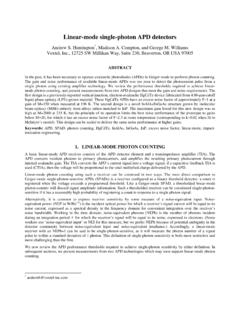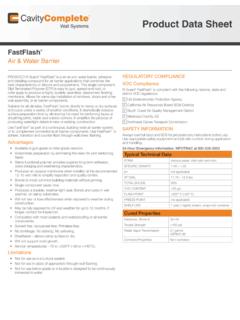Transcription of Introduction Feature
1 8-bit AVR Microcontrollers ATmega328/P DATASHEET SUMMARYI ntroductionThe Atmel picoPower ATmega328/P is a low-power CMOS 8-bitmicrocontroller based on the AVR enhanced RISC architecture. Byexecuting powerful instructions in a single clock cycle, the ATmega328/Pachieves throughputs close to 1 MIPS per MHz. This empowers systemdesigner to optimize the device for power consumption versus Performance, Low Power Atmel AVR 8-Bit Microcontroller Family Advanced RISC Architecture 131 Powerful Instructions Most Single Clock Cycle Execution 32 x 8 General Purpose Working Registers Fully Static Operation Up to 20 MIPS Throughput at 20 MHz On-chip 2-cycle Multiplier High Endurance Non-volatile Memory Segments 32 KBytes of In-System Self-Programmable Flash programMemory 1 KBytes EEPROM 2 KBytes Internal SRAM Write/Erase Cycles.
2 10,000 Flash/100,000 EEPROM Data Retention: 20 years at 85 C/100 years at 25 C(1) Optional Boot Code Section with Independent Lock Bits In-System Programming by On-chip Boot Program True Read-While-Write Operation Programming Lock for Software Security Atmel QTouch Library Support Capacitive Touch Buttons, Sliders and Wheels QTouch and QMatrix Acquisition Up to 64 sense channelsAtmel-42735B-328/P_Datasheet_Sum mary-11/2016 Peripheral Features Two 8-bit Timer/Counters with Separate Prescaler and Compare Mode One 16-bit Timer/Counter with Separate Prescaler, Compare Mode.
3 And Capture Mode Real Time Counter with Separate Oscillator Six PWM Channels 8-channel 10-bit ADC in TQFP and QFN/MLF package Temperature Measurement 6-channel 10-bit ADC in PDIP Package Temperature Measurement Two Master/Slave SPI Serial Interface One Programmable Serial USART One Byte-oriented 2-wire Serial Interface (Philips I2C compatible) Programmable Watchdog Timer with Separate On-chip Oscillator One On-chip Analog Comparator Interrupt and Wake-up on Pin Change Special Microcontroller Features Power-on Reset and Programmable Brown-out Detection Internal Calibrated Oscillator External and Internal Interrupt Sources Six Sleep Modes: Idle, ADC Noise Reduction, Power-save, Power-down, Standby, andExtended Standby I/O and Packages 23 Programmable I/O Lines 28-pin PDIP, 32-lead TQFP, 28-pad QFN/MLF and 32-pad QFN/MLF Operating Voltage.
4 - Temperature Range: -40 C to 105 C speed Grade: 0 - 4 MHz @ - 0 - 10 MHz @ - 0 - 20 MHz @ - Power Consumption at 1 MHz, , 25 C Active Mode: Power-down Mode: A Power-save Mode: A (Including 32kHz RTC)Atmel ATmega328/P [DATASHEET]Atmel-42735B-328/P_Datasheet_ Summary-11/20162 Table of Information .. Code Touch DescriptionThe Atmel AVR core combines a rich instruction set with 32 general purpose working registers. All the32 registers are directly connected to the Arithmetic Logic Unit (ALU), allowing two independent registersto be accessed in a single instruction executed in one clock cycle.
5 The resulting architecture is more codeefficient while achieving throughputs up to ten times faster than conventional CISC ATmega328/P provides the following features: 32 Kbytes of In-System Programmable Flash withRead-While-Write capabilities, 1 Kbytes EEPROM, 2 Kbytes SRAM, 23 general purpose I/O lines, 32general purpose working registers, Real Time Counter (RTC), three flexible Timer/Counters with comparemodes and PWM, 1 serial programmable USARTs , 1 byte-oriented 2-wire Serial Interface (I2C), a 6-channel 10-bit ADC (8 channels in TQFP and QFN/MLF packages) , a programmable Watchdog Timerwith internal Oscillator, an SPI serial port, and six software selectable power saving modes.
6 The Idlemode stops the CPU while allowing the SRAM, Timer/Counters, SPI port, and interrupt system tocontinue functioning. The Power-down mode saves the register contents but freezes the Oscillator,disabling all other chip functions until the next interrupt or hardware reset. In Power-save mode, theasynchronous timer continues to run, allowing the user to maintain a timer base while the rest of thedevice is sleeping. The ADC Noise Reduction mode stops the CPU and all I/O modules exceptasynchronous timer and ADC to minimize switching noise during ADC conversions.
7 In Standby mode, thecrystal/resonator oscillator is running while the rest of the device is sleeping. This allows very fast start-upcombined with low power consumption. In Extended Standby mode, both the main oscillator and theasynchronous timer continue to offers the QTouch library for embedding capacitive touch buttons, sliders and wheels functionalityinto AVR microcontrollers. The patented charge-transfer signal acquisition offers robust sensing andincludes fully debounced reporting of touch keys and includes Adjacent Key Suppression (AKS )technology for unambiguous detection of key events.
8 The easy-to-use QTouch Suite toolchain allows youto explore, develop and debug your own touch device is manufactured using Atmel s high density non-volatile memory technology. The On-chip ISPF lash allows the program memory to be reprogrammed In-System through an SPI serial interface, by aconventional nonvolatile memory programmer, or by an On-chip Boot program running on the AVR Boot program can use any interface to download the application program in the Application Flashmemory. Software in the Boot Flash section will continue to run while the Application Flash section isupdated, providing true Read-While-Write operation.
9 By combining an 8-bit RISC CPU with In-SystemSelf-Programmable Flash on a monolithic chip, the Atmel ATmega328/P is a powerful microcontroller thatprovides a highly flexible and cost effective solution to many embedded control ATmega328/P is supported with a full suite of program and system development tools including: CCompilers, Macro Assemblers, Program Debugger/Simulators, In-Circuit Emulators, and Evaluation ATmega328/P [DATASHEET]Atmel-42735B-328/P_Datasheet_ Summary-11/201642. Configuration SummaryFeaturesATmega328/PPin Count28/32 Flash (Bytes)32 KSRAM (Bytes)2 KEEPROM (Bytes)1 KInterrupt Vector Size (instruction word/vector)1/1/2 General Purpose I/O Lines23 SPI2 TWI (I2C)1 USART1 ADC10-bit 15kSPSADC Channels88-bit Timer/Counters216-bit Timer/Counters1and support a real Read-While-Write Self-Programming mechanism.
10 There is a separate Boot LoaderSection, and the SPM instruction can only execute from there. In , there is no Read-While-Write supportand no separate Boot Loader Section. The SPM instruction can execute from the entire ATmega328/P [DATASHEET]Atmel-42735B-328/P_Datasheet_ Summary-11/201653. Ordering ATmega328 speed [MHz](3)Power Supply [V]Ordering Code(2)Package(1)Operational - (5)ATmega328-MMH(4)ATmega328-MMHR(4)(5)A Tmega328-MUAT mega328-MUR(5)ATmega328-PU32A32A28M128M1 32M1-A32M1-A28P3 Industrial(-40 C to 85 C)Note: 1. This device can also be supplied in wafer form.
















